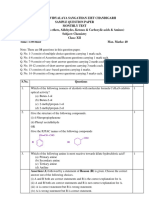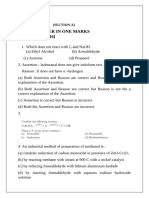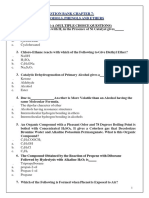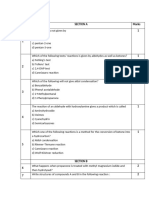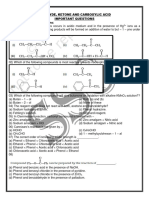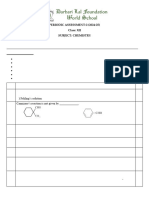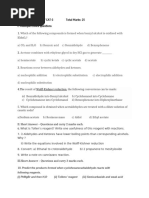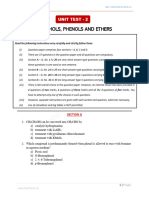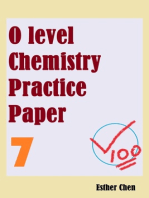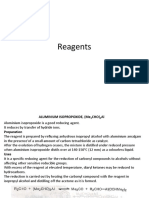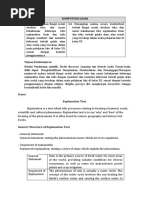0 ratings0% found this document useful (0 votes)
154 viewsAlcohol, Phenol Ether
Alcohol, Phenol Ether
Uploaded by
Somu Yashawant ChaudhariThis document contains a class test on Chapter 1 of Alcohol Phenol & Ethers. It includes 4 sections with multiple choice and short answer questions. Section 1 has 7 multiple choice questions testing concepts like hybridization of carbon in phenol, reagents used to reduce acetaldehyde to ethanol, and polymers of formaldehyde. Section 2 has short answer questions testing knowledge of alcohol classification, reagents to convert phenol to different compounds, preparation of diethyl ether, and uses of phenol and diethyl ether. Section 3 asks to explain reactions like Kolbe-Schmitt reaction and functional group reactions on anisole. Section 4 asks about crown ethers, the reaction of an ether with HBr, Williamson and Wurtz synthesis
Copyright:
© All Rights Reserved
Available Formats
Download as DOCX, PDF, TXT or read online from Scribd
Alcohol, Phenol Ether
Alcohol, Phenol Ether
Uploaded by
Somu Yashawant Chaudhari0 ratings0% found this document useful (0 votes)
154 views1 pageThis document contains a class test on Chapter 1 of Alcohol Phenol & Ethers. It includes 4 sections with multiple choice and short answer questions. Section 1 has 7 multiple choice questions testing concepts like hybridization of carbon in phenol, reagents used to reduce acetaldehyde to ethanol, and polymers of formaldehyde. Section 2 has short answer questions testing knowledge of alcohol classification, reagents to convert phenol to different compounds, preparation of diethyl ether, and uses of phenol and diethyl ether. Section 3 asks to explain reactions like Kolbe-Schmitt reaction and functional group reactions on anisole. Section 4 asks about crown ethers, the reaction of an ether with HBr, Williamson and Wurtz synthesis
Original Description:
Alcohol, Phenol Ether
Copyright
© © All Rights Reserved
Available Formats
DOCX, PDF, TXT or read online from Scribd
Share this document
Did you find this document useful?
Is this content inappropriate?
This document contains a class test on Chapter 1 of Alcohol Phenol & Ethers. It includes 4 sections with multiple choice and short answer questions. Section 1 has 7 multiple choice questions testing concepts like hybridization of carbon in phenol, reagents used to reduce acetaldehyde to ethanol, and polymers of formaldehyde. Section 2 has short answer questions testing knowledge of alcohol classification, reagents to convert phenol to different compounds, preparation of diethyl ether, and uses of phenol and diethyl ether. Section 3 asks to explain reactions like Kolbe-Schmitt reaction and functional group reactions on anisole. Section 4 asks about crown ethers, the reaction of an ether with HBr, Williamson and Wurtz synthesis
Copyright:
© All Rights Reserved
Available Formats
Download as DOCX, PDF, TXT or read online from Scribd
Download as docx, pdf, or txt
0 ratings0% found this document useful (0 votes)
154 views1 pageAlcohol, Phenol Ether
Alcohol, Phenol Ether
Uploaded by
Somu Yashawant ChaudhariThis document contains a class test on Chapter 1 of Alcohol Phenol & Ethers. It includes 4 sections with multiple choice and short answer questions. Section 1 has 7 multiple choice questions testing concepts like hybridization of carbon in phenol, reagents used to reduce acetaldehyde to ethanol, and polymers of formaldehyde. Section 2 has short answer questions testing knowledge of alcohol classification, reagents to convert phenol to different compounds, preparation of diethyl ether, and uses of phenol and diethyl ether. Section 3 asks to explain reactions like Kolbe-Schmitt reaction and functional group reactions on anisole. Section 4 asks about crown ethers, the reaction of an ether with HBr, Williamson and Wurtz synthesis
Copyright:
© All Rights Reserved
Available Formats
Download as DOCX, PDF, TXT or read online from Scribd
Download as docx, pdf, or txt
You are on page 1of 1
Class Test -1
Chapter 1: Alcohol Phenol & Ethers
Q. 1: Multiple choice questions (7 marks)
1. In phenol carbon atom attached to -OH group undergoes ________.?
(A) sp3 hybridisation (B) sp hybridization (C) sp2 hybridisation (D) no hybridisation.
2. Which among the following reducing agents is NOT used to reduce acetaldehyde to ethyl
alcohol?
(A) Na-Hg and water (B) Zn-Hg and conc. HCl (C) H2-Raney Ni (D) LiAlH4/H+
3. Bakelite is the polymer of _______.
(A) Benzaldehyde and phenol (B) Acetaldehyde and phenol
(C) Formaldehyde and phenol (D) Formaldehyde and benzyl alcohol
4. Chloro ethane reacts with X to form diethyl ether. What is X
(A)NaOH (B)H2SO4 (C )C2H5ONa (D)Na2S2O3
5. In Williamson's synthesis
A)an alcohol is heated with conc. H2SO4 at 140°C B)an alkyl halide is treated with sodium
C)an alkyl halide is treated with sodium alkoxide D)None of the above
6. Methyl phenyl ether can be obtained by reacting
A)phenolate ions and methyl iodide B)methoxide ions and bromobenzene
C)methanol and phenol D)bromobenzene and methyl bromide
7. Which of the following is Lucas reagent?
(A) ZnCl2/con HCl (B) Br2/CCl4 (C) Ammoniacal silver nitrate (D) Cold Alkaline KMnO4
Q. 2: Solve the followings (Any 6) (12 marks)
1. What are alcohols? How they are classified?
2. Name the reagents used to convert phenol into 1. picric acid 2. 2,4,6-tribromophenol 3. benzene.
3. What is the action of following reagents on phenol.
i. Bromine in CS2 at low temp. ii. Dil. HNO3 at RT.
4. How diethyl ether prepared by continuous eherification process?
5. Give uses of phenol and diethyl ether.
6.how will you prepare 2-methyl butane-1-ol from an alkene.
7. how will you prepare methoxyethane from alkyl halide?
8. write structures of 1. 1-Ethylcyclohexanol 2. Hex-3-en-2-ol
Q. 3: solve the followings (Any 3) (9 marks)
1. Explain Kolbe and Riemer-Tiemann reaction.
2. Explain bromination, nitration, friedel craft alkylation and acylation of anisole.
3. Explain: I) Phenol is more acidic than ethanol.
4. How propane-1-ol prepared from Propanal & Propanoic acid..
5. How phenol is prepared from Clorobenzene, Isopropyl benzene & Aniline.
Q. 4. Solve the following. (7 mark)
1. crown ether
2. CH3-CH2-CH2-O-CH3 + HBr gives?
3. Williamson & Wurtz Synthesis
4. Give uses of alcohol.
You might also like
- 8401 Atmos Cube Operating-Manual en V 1.0Document49 pages8401 Atmos Cube Operating-Manual en V 1.0André Guerreiro Jr.No ratings yet
- Hypalon 4085 Spec SheetDocument18 pagesHypalon 4085 Spec SheetpadrititaNo ratings yet
- Chapter - 10 (Test Paper - Haloalkane and Haloarene) : Saint S.R.S School Class-Xii Chemistry (Theory)Document2 pagesChapter - 10 (Test Paper - Haloalkane and Haloarene) : Saint S.R.S School Class-Xii Chemistry (Theory)Shivank KurmiNo ratings yet
- Monthly Test Xii Chemistry October 2023-24Document4 pagesMonthly Test Xii Chemistry October 2023-24soumityachaudharyNo ratings yet
- 3333Document7 pages3333vathithya5No ratings yet
- TEST-7 ELITE (C-7&8)Document2 pagesTEST-7 ELITE (C-7&8)tarunmathur7777No ratings yet
- Class XII Alcohols Phenols EthersDocument7 pagesClass XII Alcohols Phenols EthersvartikasinghNo ratings yet
- ALCOHOLS, PHENOLS & ETHERS QuesDocument12 pagesALCOHOLS, PHENOLS & ETHERS Quesaryaveer376No ratings yet
- Aldehyde KetonesDocument10 pagesAldehyde Ketonesmitadru.cricketNo ratings yet
- Alcohols, Phenols and EthersDocument3 pagesAlcohols, Phenols and EthersCJ's Music GalleryNo ratings yet
- 1111Document8 pages1111shatrudhan2007lkNo ratings yet
- Aldehyde and KetoneDocument3 pagesAldehyde and KetonePrabhleen KaurNo ratings yet
- Aldehyde and ketoneDocument3 pagesAldehyde and ketonePrabhleen KaurNo ratings yet
- 11. Alcohols, Phenols and ethers (2)Document10 pages11. Alcohols, Phenols and ethers (2)hanank6622No ratings yet
- Alcohols, Phenols and Ethers WorksheetDocument12 pagesAlcohols, Phenols and Ethers WorksheetksvyamunaaNo ratings yet
- ALCOHOLS__PHENOLS_AND_ETHERSDocument6 pagesALCOHOLS__PHENOLS_AND_ETHERSsovonchatterjee2003No ratings yet
- Question Bank Chemistry Class - XiiDocument49 pagesQuestion Bank Chemistry Class - Xiichauhanneeru70No ratings yet
- Aldehyde, Ketone and Carboxylic AcidDocument10 pagesAldehyde, Ketone and Carboxylic Acidgoodgirlz946No ratings yet
- XII Chem PA-2 QPDocument4 pagesXII Chem PA-2 QPManishaNo ratings yet
- Previous HSE Questions and Answers For The Chapter "Alcohols, Phenols and Ethers"Document10 pagesPrevious HSE Questions and Answers For The Chapter "Alcohols, Phenols and Ethers"Adithya K SanjeevNo ratings yet
- 12th Che Alcohols, Phenols and Ethers QDocument4 pages12th Che Alcohols, Phenols and Ethers QSRK laptopNo ratings yet
- Xi-Chem-Pyq-Ans-7. Alcohols, PhenolsDocument13 pagesXi-Chem-Pyq-Ans-7. Alcohols, PhenolskrishnaswamyharikaNo ratings yet
- Unit 8,9 and 10 Worksheet - QUESTION BANK GR 12Document25 pagesUnit 8,9 and 10 Worksheet - QUESTION BANK GR 12Tvisha MalikNo ratings yet
- 12th Che Alcohols, Phenols and Ethers Q&ADocument7 pages12th Che Alcohols, Phenols and Ethers Q&ASRK laptopNo ratings yet
- Revision IVqpDocument3 pagesRevision IVqppranavsankar388No ratings yet
- 12 Achievers T1Document4 pages12 Achievers T1hashitaa.v2007No ratings yet
- Alcohols Phenols EthersDocument28 pagesAlcohols Phenols Ethersmanyaaatripathi.25No ratings yet
- Unit 12 Aldehysdes Ketones and Carboxylic AcidsDocument4 pagesUnit 12 Aldehysdes Ketones and Carboxylic Acidspavankumar3905syNo ratings yet
- Int test 01 pdfDocument1 pageInt test 01 pdfjanjee413No ratings yet
- Alcohols, Phenols & Ethers QPDocument3 pagesAlcohols, Phenols & Ethers QPIniya RajasekharNo ratings yet
- Question paper Orgainc OnlyDocument5 pagesQuestion paper Orgainc OnlytattavramdarshanNo ratings yet
- Hydrocarbon QuestionDocument4 pagesHydrocarbon Question123rehanbrualamNo ratings yet
- Class 12chemistry - Alcohol, Phenol and Ether - McqsDocument22 pagesClass 12chemistry - Alcohol, Phenol and Ether - McqsShypackofcheetosNo ratings yet
- Class 12th Bimonthly Exam NovemberDocument2 pagesClass 12th Bimonthly Exam NovemberKritikaNo ratings yet
- Class: Xii Max. Marks: 50 Subject: Chemistry. TIME: 2 HoursDocument2 pagesClass: Xii Max. Marks: 50 Subject: Chemistry. TIME: 2 HoursPrerak Kumar SharmaNo ratings yet
- WS-3 - XII - Organic Chemistry - 22-23Document9 pagesWS-3 - XII - Organic Chemistry - 22-23ridhimanchetia2No ratings yet
- Alcohol Phenol and Ethers QBDocument2 pagesAlcohol Phenol and Ethers QBJayaram VimalaNo ratings yet
- Test Series ALCOHOL PHENOL ETHERSDocument3 pagesTest Series ALCOHOL PHENOL ETHERSShivani SharmaNo ratings yet
- Organic Chem II - MS - 230116 - 103256Document6 pagesOrganic Chem II - MS - 230116 - 103256kiama kariithiNo ratings yet
- Assignment 1 Organic Chem XIIDocument4 pagesAssignment 1 Organic Chem XIIzoroislostopNo ratings yet
- Delhi Public School Vadodara: Academic Session 2023 - 24 Periodic Test 1Document5 pagesDelhi Public School Vadodara: Academic Session 2023 - 24 Periodic Test 1sanjnapoddar837No ratings yet
- ORGANIC REVISIONDocument66 pagesORGANIC REVISIONAditya RiseNo ratings yet
- organic chemDocument6 pagesorganic chemSouri MeherNo ratings yet
- Alcohols Phenols and Ethers.docxDocument3 pagesAlcohols Phenols and Ethers.docxVinithakumari TSNo ratings yet
- Alcohol, Phenols and EtherDocument4 pagesAlcohol, Phenols and EtherShayaan & friend's vlogNo ratings yet
- Organic QpDocument3 pagesOrganic QpTrakin SmartNo ratings yet
- CR-CHE-7-ALCOHOLS PHENOLS AND ETHERSDocument12 pagesCR-CHE-7-ALCOHOLS PHENOLS AND ETHERStpriyanshu972No ratings yet
- WORKSHEET 3Document2 pagesWORKSHEET 3Joash JaxonNo ratings yet
- XII Chemistry - Frequently Asked Question Bank PDFDocument175 pagesXII Chemistry - Frequently Asked Question Bank PDFYASH PATELNo ratings yet
- 0 - Assignment 4 2019-20Document7 pages0 - Assignment 4 2019-20Sanjeev NarangNo ratings yet
- Class-XII (Chemistry) Chapter: Alcohols, Phenols and Ethers Objective Type QuestionsDocument9 pagesClass-XII (Chemistry) Chapter: Alcohols, Phenols and Ethers Objective Type QuestionsPranav DhimanNo ratings yet
- XII Chemistry Q.B.24-25Document6 pagesXII Chemistry Q.B.24-25bansalaryashNo ratings yet
- Revision Questions Ald, Ket - CacidDocument3 pagesRevision Questions Ald, Ket - Cacidmail.gagan2025No ratings yet
- Qp class12 OG -Document2 pagesQp class12 OG -gopikauu973No ratings yet
- XII- CHEMISRTY - Work sheetDocument3 pagesXII- CHEMISRTY - Work sheetscharanreddy2007No ratings yet
- CBSE Sample Paper Class 12 Chemistry Set 6Document4 pagesCBSE Sample Paper Class 12 Chemistry Set 6Sidharth SabharwalNo ratings yet
- Grade 12 CAT 5 Aldehyde Ketone Carboxylic AcidDocument2 pagesGrade 12 CAT 5 Aldehyde Ketone Carboxylic Acidshivadhurga316No ratings yet
- Alcohols, Phenols and Ethers - Unit TestDocument7 pagesAlcohols, Phenols and Ethers - Unit TestnishumodsharaNo ratings yet
- sample pappaerDocument4 pagessample pappaermohmmadbarrak2007712No ratings yet
- CH 11Document2 pagesCH 11anubhavpatnaik2007No ratings yet
- Practice Makes Perfect in Chemistry: Acids, Bases, and Salts with AnswersFrom EverandPractice Makes Perfect in Chemistry: Acids, Bases, and Salts with AnswersNo ratings yet
- Chapter18EAS Groups PDFDocument1 pageChapter18EAS Groups PDFSomu Yashawant ChaudhariNo ratings yet
- Vision Mission Goal 2019Document2 pagesVision Mission Goal 2019Somu Yashawant ChaudhariNo ratings yet
- Substituent Effects: Electron Donating GroupsDocument1 pageSubstituent Effects: Electron Donating GroupsSomu Yashawant ChaudhariNo ratings yet
- 2.lab Techniques (Repaired) PDFDocument52 pages2.lab Techniques (Repaired) PDFSomu Yashawant ChaudhariNo ratings yet
- Maharashtra State Board of Secondary and Higher Secondary Education H.S.C 2009 - 2010 March 12th Board Exam Physics 1Document3 pagesMaharashtra State Board of Secondary and Higher Secondary Education H.S.C 2009 - 2010 March 12th Board Exam Physics 1Somu Yashawant ChaudhariNo ratings yet
- ReagentsDocument5 pagesReagentsSomu Yashawant ChaudhariNo ratings yet
- 2011 Questions 3Document3 pages2011 Questions 3Somu Yashawant ChaudhariNo ratings yet
- The First 18 ElementsDocument4 pagesThe First 18 ElementsSomu Yashawant Chaudhari100% (1)
- 2012 Solutions 1Document25 pages2012 Solutions 1Somu Yashawant ChaudhariNo ratings yet
- JEE (MAIN) - 2015 (Physics, Chemistry and Mathematics) Code - A (Solutions)Document43 pagesJEE (MAIN) - 2015 (Physics, Chemistry and Mathematics) Code - A (Solutions)Somu Yashawant ChaudhariNo ratings yet
- Maharashtra State Board of Secondary and Higher Secondary Education H.S.C 2007 - 2008 March 12th Board Exam Mathematics and Statistics 1Document3 pagesMaharashtra State Board of Secondary and Higher Secondary Education H.S.C 2007 - 2008 March 12th Board Exam Mathematics and Statistics 1Somu Yashawant ChaudhariNo ratings yet
- Solid States Question PaperDocument1 pageSolid States Question PaperSomu Yashawant ChaudhariNo ratings yet
- Solid States Question PaperDocument1 pageSolid States Question PaperSomu Yashawant ChaudhariNo ratings yet
- Pneuminics Periodic TableDocument2 pagesPneuminics Periodic TableSomu Yashawant ChaudhariNo ratings yet
- CHAPTER 1 4 For CorrectionDocument24 pagesCHAPTER 1 4 For CorrectionVin HinayNo ratings yet
- Wax Luster RDocument3 pagesWax Luster Rkharan rasmusNo ratings yet
- Kompotensi Dasar: Explanation TextDocument21 pagesKompotensi Dasar: Explanation TextSakina UtinaNo ratings yet
- Data Sheet Fillerlite Spheroid Particles ArchitectureDocument1 pageData Sheet Fillerlite Spheroid Particles ArchitectureCanchindoNo ratings yet
- Parke Davis & Co. v. Doctor's PharmaceuticalsDocument1 pageParke Davis & Co. v. Doctor's PharmaceuticalsAliw del RosarioNo ratings yet
- LabExercise3 2Document21 pagesLabExercise3 2EUNICE JOI SARCONNo ratings yet
- Essentials of Medical Pharmacology Seventh Edition KD TRIPATHI MD_ExtractedDocument16 pagesEssentials of Medical Pharmacology Seventh Edition KD TRIPATHI MD_ExtractedRakesh MakwanaNo ratings yet
- Photosynthesis Presentation NXPowerLiteDocument23 pagesPhotosynthesis Presentation NXPowerLite3DSツTRĪCKSHØTNo ratings yet
- CABERIO AB21 LABORATORY REPORT NO. 3 Microbio LABDocument5 pagesCABERIO AB21 LABORATORY REPORT NO. 3 Microbio LABJohn Mark Gallano CanayonNo ratings yet
- 74695209532Document2 pages74695209532KoniNo ratings yet
- Datasheet For Steel Grades Carbon Steel SAE 1090Document2 pagesDatasheet For Steel Grades Carbon Steel SAE 1090Todd FlowNo ratings yet
- 3rd Year BiologyDocument11 pages3rd Year BiologyScribdTranslationsNo ratings yet
- Palm Oil Fuel Ash As A Partial Cement ReplacementDocument30 pagesPalm Oil Fuel Ash As A Partial Cement ReplacementBAVIRISHETTY JAYKUMARNo ratings yet
- Melc-Based Science DLL Quarter 1 Week 3Document5 pagesMelc-Based Science DLL Quarter 1 Week 3Desiree Kae Zafra BonifacioNo ratings yet
- Unit 8. Physiological Disorders of Fruits Vegetables 04.2022Document29 pagesUnit 8. Physiological Disorders of Fruits Vegetables 04.2022Tai LeNo ratings yet
- Carbohydrates, Lipid and Protein Metabolism: Guyton and Hall Textbook of Medical Physiology (14th Ed.), Chapters 68-70Document107 pagesCarbohydrates, Lipid and Protein Metabolism: Guyton and Hall Textbook of Medical Physiology (14th Ed.), Chapters 68-70Prixie AntonioNo ratings yet
- 2023 Year 7 Science Yearly ExamDocument19 pages2023 Year 7 Science Yearly Examdchen2029No ratings yet
- Pelletization of El Dekhila Iron Oxide Waste and Reduced It by Hydrogen Gas1Document8 pagesPelletization of El Dekhila Iron Oxide Waste and Reduced It by Hydrogen Gas1Ahmed KhalifaNo ratings yet
- Printing Ink Additives: Portfolio For Flexo & Opv SystemsDocument4 pagesPrinting Ink Additives: Portfolio For Flexo & Opv Systemsandrea bertaniNo ratings yet
- Different Systems of Epoxy FlooringDocument11 pagesDifferent Systems of Epoxy FlooringSharon JNo ratings yet
- 1-s2.0-S0023643817301354-Rajiv Dhital Strawberry Shelf Life 2017Document28 pages1-s2.0-S0023643817301354-Rajiv Dhital Strawberry Shelf Life 2017Andres FAGNo ratings yet
- E Waste ManagementDocument15 pagesE Waste Managementdeepakk.swmsNo ratings yet
- Student Exploration: Plants and SnailsDocument4 pagesStudent Exploration: Plants and SnailssashellNo ratings yet
- CT Sas 2Document4 pagesCT Sas 2ph28xhhcxsNo ratings yet
- Ekaland & Vultac® Range For Rubber Application: P P P PDocument1 pageEkaland & Vultac® Range For Rubber Application: P P P Pjulius hasan33No ratings yet
- Nitric Acid Is Produced by Two Methods: 8.8.1 GeneralDocument4 pagesNitric Acid Is Produced by Two Methods: 8.8.1 Generalحاتم غيدان خلفNo ratings yet
- C1 Practical WB (Hod)Document10 pagesC1 Practical WB (Hod)ahtbat1No ratings yet
- Q and A For Meo Class 2Document193 pagesQ and A For Meo Class 2andy marinerNo ratings yet



